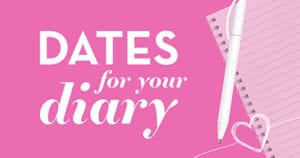You’ll wear your wedding ring every day once you’re married, so it makes sense to take your time picking the perfect band
Words by Anna Burnside
Some girls get engaged with a pre-existing knowledge of sparklers and bling: the ins and outs of cut versus clarity, the pros and cons of different precious metals. Lucky them. Others think jewellery shopping means a whirl round Topshop for some new dangly earrings. If that is you, choosing an engagement and wedding ring can be a daunting prospect. These are not just pieces of jewellery to wear every single day for the rest of your life, they are also investments that may become family heirlooms. They could well cost more than a car. So it’s important to get them right.
HALO THERE
Wedding and engagement rings are as susceptible to fashion as shoes and handbags. Yellow gold, for example, is about as common these days as a crochet kaftan. Big fat wedding bands with skinny solitaires have disappeared. Halo clusters, on the other hand, especially ones on double bands, are having their moment in the sun. But sapphires, Kate Middleton’s rock of choice, have not enjoyed much of a royal bounce.
Jessica Biel, Kelly Clarkson, Brooke Shields and Mariah Carey are just some of the celebrities who are rocking the halo cluster: a huge stone (usually a diamond) with smaller diamonds round the edge (and often on the band as well). Their husbands, however, can afford to put several carats-worth of sparkler in the centre. What about those of us who struggle to afford several carrots?
Lorna Reynolds of Colin Campbell & Co has a solution. “We get girls coming in with pictures of reality stars and celebrities wearing these big halo-style rings. They look great on a large scale. But the main cost is the jewel at the centre. We suggest they use a coloured stone instead of a diamond in the centre.”
This brings the price down to civilian level. Morganite, a pale pink semi-precious stone that is pretty and sparkly, is very popular. But there is a downside: “It’s nothing like as hard-wearing as a diamond. Diamonds are popular for a reason!” Lorna also thinks that, ten years from now, a huge morganite ring might look dated. On the other hand, a chip to a morganite stone is less of a disaster than a damaged diamond, and she anticipates that, in five years’ time, she will be swapping the worn centre stones for something different.

CLASSIC ROCK
There is a lot to be said for the traditional diamond solitaire. “Diamonds and gemstones come in all shapes and sizes, but it’s not the size of the stone that counts, it’s the quality,” says Michael Laing of Laing Edinburgh. “The rule when choosing a diamond is to consider the five Cs: colour, clarity, cut, carat and certification. I hand-pick every single Laing diamond, with only 3% making the grade.”
A ‘colourless’ diamond – graded with the letter D – is the best white diamond you can buy. “These absorb more light and breathe out more fire and brilliance,” explains Michael. As the stones move down the alphabet they become more and more yellow.
As for clarity, the majority of diamonds outwith the Elizabeth Taylor league have minor flaws – called ‘inclusions’ – which are invisible to the naked eye. Some can have visible inclusions or blemishes on the surface.
The cut releases the beauty of a diamond. Among the most popular cuts are round, emerald, marquise, radiant, asscher, oval, pear, princess and cushion, to say nothing of the new favourite, Hearts On Fire. A well-cut diamond will, says Michael, “dazzle across a room. A poorly cut diamond needs more light to stand out, where a perfectly cut diamond will show fire and brilliance. Think of it like the difference in brightness between a 40-watt and a 100-watt bulb.”
Carat refers to the weight of your diamond. The fifth C is certification. Every diamond over 0.4cts should come with an Independent Laboratory Certificate. “Never buy an uncertified diamond, and check that the certificate is actually from a respected laboratory, such as British Gem Laboratory, Diamond High Council (Antwerp) or the International Gemmological Institute,” advises Michael. “Do not be fooled by what seems like an amazing deal on the internet.”
Among the five Cs, everyone will have to make compromises, as Lorna Reynolds explains: “It’s a trade-off. Do you go for a smaller stone with better colour or a bigger stone with a drop in the colour and clarity?” It just depends on the customer’s preference. “One bride recently said to me: ‘I’d rather have more zing than bling.’”
“I find that people often look at coloured diamonds – pinks and yellows – but rarely buy them,” says Summera Shah of The Diamond Studio. “When it comes for the crunch, most people go for white.”
METAL GURU
The key considerations when choosing the metal band – apart from aesthetic preference – are budget and lifestyle. Like diamonds, gold comes in different carats: 24ct is pure; 22ct,18ct and so on will have a proportion of copper, silver or palladium added. “Gold is the traditional metal of choice,” says Michael Laing. “But a high-carat gold is relatively soft, so it’s not a great choice if you’re constantly working with your hands. More and more people are choosing white gold, titanium, palladium and platinum. Platinum is the hardest-wearing and most expensive metal, but palladium or white gold have a similar colour and appearance and both are more affordable.”
Lorna Reynolds sells white gold with a wealth warning: it requires ongoing maintenance. “We explain that it will need to be regularly replated with rhodium. Many customers are upgrading to platinum as a result, which has no upkeep issues.”
She is also seeing a demand for rose gold, which complements white gold and silver. Yellow gold, out of fashion for years, is making a comeback at a high-fashion level. The high street, however, is still awash with the white metals.
“Lifestyle definitely has an impact on your ring style and metal choice,” adds Michael. “The harder you are on your rings, the more damage and knocks they could sustain. If you are regularly handling glasses or lifting things, a wedding band set with diamonds around it or stones in high-set claws may get damaged.”
“Hairdressers are disastrous with white gold,” notes Lorna, who has had to rescue a few sorry specimens. She also recently made a solitaire with a rub-over setting (a ring of metal around the stone) for an outdoorsy bride who loves riding. “It’s ideal for her. Nothing to catch on.”
RING THE CHANGES
In all the excitement of the sparklers, it’s easy to forget about the wedding band that will accompany the engagement ring. “Wedding rings often come late on in the planning and budget,” says Lorna, “and quite often the budget is all used up.”
To avoid any last-minute financial embarrassment, she suggests trying on wedding bands at the same time as engagement rings and factoring in the cost (especially if you want a diamond-studded band, as many brides do) at that stage. If it’s too late for that, she suggests buying a plain band and then adding a diamond for the first anniversary, a blue sapphire for a baby boy or a pink one for a girl. (No one has yet requested an emerald for an alien birth.)
This is also the time to make sure the two rings fit well together. “These should complement each other and sit flush,” says Michael. “The key thing is not the leave the buying of the ring to the last minute. You need to give the jeweller time to get the ring designed and made, so at least three months before your big day is a sensible timescale.”
“When a bride is trying on engagement rings I always get her to try on a wedding ring with them, to make sure they fit and match,” says Summera Shah. “And the wedding ring has got to be a nice piece of jewellery on its own.”
Should the groom’s ring match the bride’s? “There is no hard and fast rule with this – everyone is an individual and it’s down to whether or not you particularly want to complement or match each other,” says Michael. “It’s quite traditional to match your wedding rings, and a lot of couples do it, with the brides opting for diamonds or design twists to add something different.
“Having the same precious metal wedding bands as each other might be enough. Men normally opt for a broader band than women, but as long as it is the same metal, it makes it even more special knowing they match.”
Summera, who makes many bespoke rings, reports that men are requesting his-and-hers diamonds. She recently made a black diamond ring for one groom with very pale hands. “It really suited him.”
And even if the groom wants a custom-designed chunky Celtic band to match his tattoos (Lorna was recently commissioned to make one of these) and the bride has a delicate solitaire, it’s possible to engrave them both with the same message. The date of the wedding, the couple’s initials or your pet names for each other all make the ring extra personal. And it means there’s no excuse to forget the anniversary.


STAR STYLE SPARKLERS
So far, 2013 has seen a boom in celebrity engagements, including Frankie Sandford and Wayne Bridge, Elle Macpherson and Jeff Soffer, and Millie Mackintosh and Professor Green. We take a look at the popular styles of engagement rings within celebrity circles with engagement ring specialists David M. Robinson.
Solitaire, round brilliant four-claw in platinum: The word ‘solitaire’ means ‘the one’, a key reason why classic solitaire rings are extremely popular in the wedding industry. The timeless solitaire design never goes out of style and celebrities such as Scarlett Johansson and Michelle Obama are fans of this style.
Princess-cut in platinum with diamond-set shoulders: Princess-cut rings are one of the most popular larger diamond cuts. Traditionally square, the princess diamond is cut for maximum brilliance and is the perfect cut if you’re looking for a show-stopping engagement ring. Diamond-set shoulders add extra sparkle to princess-cut diamonds. This is a popular choice for celebrities – Jessica Alba has one.
Three-stone round in platinum: Known as ‘past, present and future’ rings, a three-stone ring is a beautiful alternative style. Popular with celebrities including Jessica Simpson and Christina Ricci, three-stone rings generally have a larger centrepiece diamond, surrounded by two smaller diamonds. This style works well with coloured stones too.
Round with diamond-set shoulders in platinum: From the recent picture Frankie Sandford tweeted of her new engagement ring, we think her ring looks like a large round diamond style, a classic choice from her partner Wayne Bridge. Round diamonds are more durable and are less likely to chip than many diamond shapes with sharp corners. Combined with platinum metal to support the round diamond, this ring style is extremely hard-wearing and should continue to sparkle for a lifetime.
Emerald-cut platinum four-claw: The unique, elongated emerald-cut diamond has a great vintage look and feel, and is a popular choice with celebrities such as supermodel Elle Macpherson and actresses Kate Hudson and Millie Mackintosh. The mirrored facets on emerald-cut diamonds play off the light, creating a ‘hall of mirrors’ effect that is sure to sparkle and catch your eye.
www.davidmrobinson.co.uk








